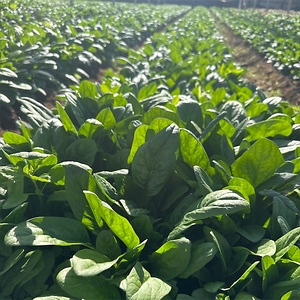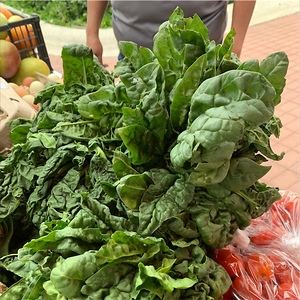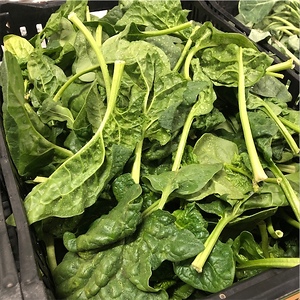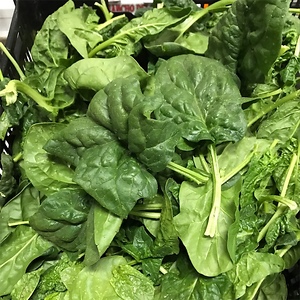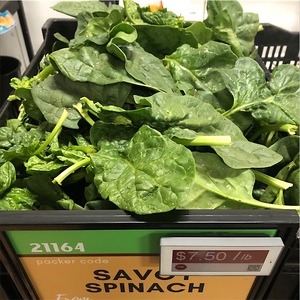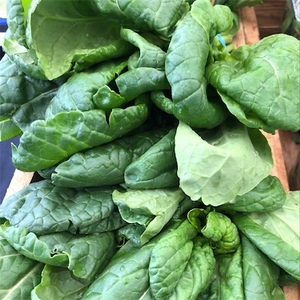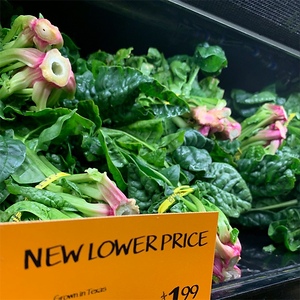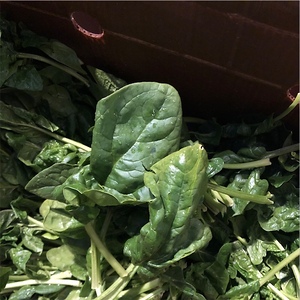


Savoy Spinach
Estimated Inventory, 3 lbs : 0
Description/Taste
Savoy spinach forms in low-growing rosettes with overlapping oval to elongated leaves averaging 12 to 15 centimeters in length. Each leaf is thick, semi-tough, and dark green, covered in lines, creases, and a raised texture. This gives the spinach a full, almost ruffled appearance, and there are also prominent veins spanning across the leaf’s surface. Savoy spinach has a crisp, springy, and chewy consistency, developing a toothsome mouthfeel as the greens mature. Young Savoy spinach leaves will impart a delicate, crisp, and subtly sweet, earthy flavor when added raw to dishes. Mature Savoy spinach has a heartier nature and bolder flavor than the more common flat-leaf spinach. The greens contribute an earthy, green, and grassy flavor with subtly bitter, mineral-forward nuances. When the greens are cooked, they will soften in texture and develop a sweeter taste.
Seasons/Availability
Savoy spinach is available year-round, with peak seasons in the spring and fall.
Current Facts
Savoy spinach, botanically classified as Spinacia oleracea, is a type of hearty spinach encompassing many different varieties belonging to the Amaranthaceae family. Botanists generally divide spinach into three main categories: flat-leaf spinach, Savoy spinach, and Semi-Savoy spinach. Savoy spinach refers to a group of spinach cultivars that produce thicker leaves with a crinkled, textured surface. These chewy, robustly flavored greens are also known as Curly Leaf spinach and are primarily incorporated into cooked preparations, favored for their consistency, flavor, and coloring. Savoy spinach is commercially cultivated worldwide, but it is also planted in home gardens, grown for its fast-maturing leaves, slow-bolting nature, resistance to some diseases, and cold-weather tolerance. The wrinkled greens are typically sold fresh in bunches and are utilized for their unique appearance as much as their mineral, earthy, and slightly bitter taste.
Nutritional Value
Savoy spinach is a source of vitamin A to maintain healthy organ functioning, vitamin C to strengthen the immune system and reduce inflammation, and vitamin K to assist in faster wound healing. The greens also provide iron to develop the protein hemoglobin for oxygen transport through the bloodstream, folate to produce healthy red blood cells, and manganese to build connective tissues, and other nutrients including fiber, potassium, calcium, copper, and zinc. Spinach is valued for containing anti-inflammatory properties and antioxidants to protect the cells against the damage caused by free radicals.
Applications
Savoy spinach has an earthy, mineral-forward flavor and chewy texture well suited for fresh and cooked preparations. It is important to note that the wrinkled nature of Savoy spinach leaves can house dirt and sand and should be washed thoroughly. The best way to clean the leaves is to swish underwater to remove any lingering debris. Once washed, Savoy spinach can be added to salads, layered into sandwiches, or shredded into grain bowls, tacos, or rice dishes. Younger Savoy leaves are preferred for raw preparations as they have a sweeter and more delicate, crisp texture. Savoy spinach is most popularly incorporated into cooked preparations as the thicker leaves withstand heat and develop a softer, silkier consistency when cooked. The greens can be sauteed in brown butter, gently wilted, and used as a bed of greens for seafood, stirred into soups and curries, or added at the end of stir-fries. Savoy spinach can also be incorporated into frittatas, quiches, omelets, or eggs benedict, cooked into souffles, blanched and mixed into cream-based sauces, made into a pesto, or wilted and tossed into pasta. Savoy spinach pairs well with meats such as lamb, turkey, beef, pork, and poultry, seafood, cheeses including feta, parmesan, mozzarella, goat, and cheddar, citrus, pomegranate seeds, leeks, peas, root vegetables, and nuts such as walnuts, almonds, and pine. Whole, unwashed Savoy spinach will keep for three days when stored loosely in a plastic bag in the refrigerator’s crisper drawer. The greens can also be frozen for extended use.
Ethnic/Cultural Info
In folklore, spinach was rumored to have been responsible for the creation of the culinary term “Florentine” or “a la Florentine.” The Italian descriptor “Florentine” was paired with the edible greens due to the influence of Catherine de’ Medici, an Italian noblewoman from Florence who married King Henry II of France in 1533. Legend has it that Catherine loved spinach so much that she brought a team of chefs from Florence with her to the French palace when she became queen to make dishes with the mineral-forward greens. Not long after she arrived in France, the French court was introduced to Catherine’s favorite spinach dishes and began to refer to them as “à la Florentine” and “Florentine.” While historians have proved this story to be a cultural tale rather than a fact, the term “Florentine” is still used in modern-day French cooking. “Florentine” refers to dishes made with spinach, protein, and a mornay sauce, a type of creamy gruyere-based bechamel. Florentine dishes commonly consist of poultry, fish, or eggs, and popular recipes include eggs Florentine, chicken Florentine, sole Florentine, and quiche Florentine.
Geography/History
Spinach is believed by botanists to be native to areas of ancient Persia, now known as modern-day Iran. The edible, domesticated greens were thought to have developed through selective breeding of wild, leafy species, but much of the history of spinach is unknown. Over time, spinach was spread to neighboring countries around Persia, traveling through India, and was introduced into Nepal and China sometime before 647 CE. Spinach was also brought to Italy around 827 CE through the Arabs, and by the 10th century, the plant was found throughout the Mediterranean. In the 13th through 16th centuries, spinach was extensively cultivated throughout Europe, creating new domesticated varieties, and the greens became a favorite ingredient of nobility and royalty. Spinach was also carried to the New World and was found in home gardens in the United States by the 19th century. Today Savoy spinach is cultivated worldwide, and in the United States, it is primarily grown on the central coast of California, specifically Salinas Valley in Monterey, Arizona, Texas, and New Jersey. The fresh greens are offered through farmers markets, specialty retailers, and select grocers.
Recipe Ideas
Recipes that include Savoy Spinach. One
| Cuisine D'eli |
|
Cannellini Beans with Savoy Spinach |
| Fine Cooking |
|
Baked Eggs with Spiced Creamed Spinach |



